#Oncorhynchus clarkii clarkii
Explore tagged Tumblr posts
Text
Critter fact #3:

The Bonneville Cutthroat Trout, Oncorhynchus clarkii utah, is the state fish of Utah. It is identified by the red mark under its lower jaw, and the presence of many large, black spots.
#Just realized I didn't make a#3#At least i don't think so#Trout#Bonneville Cutthroat Trout#Oncorhynchus clarkii utah#fish#fish facts#critter facts
167 notes
·
View notes
Text

Baby fish
#fish#animals#wildlife#animal#forest#nature#beauty#photographers on tumblr#artists on tumblr#original photographers#original photography#photography#aesthetic#Washington#pnw#westcoastbestcoast#art#vsco#pacific northwest#explore#travel#cottagecore#p#probably Oncorhynchus clarkii
58 notes
·
View notes
Text
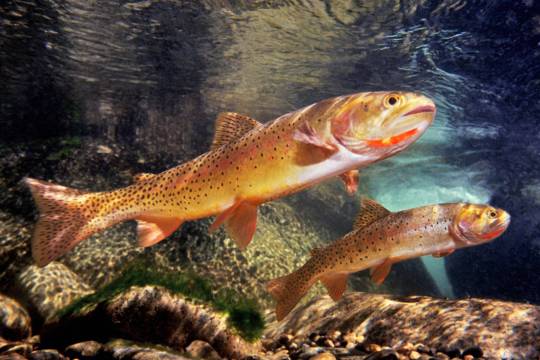
Yellowstone cutthroat trout (Oncorhynchus clarkii bouvieri)
356 notes
·
View notes
Text
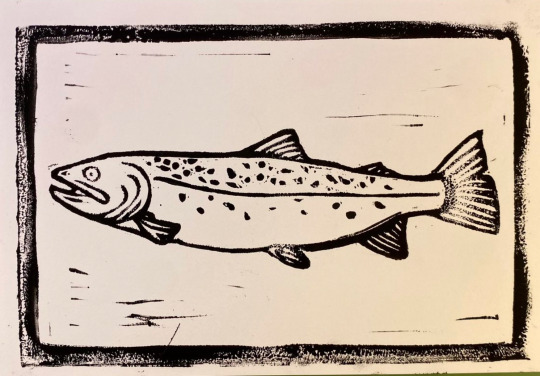
Cutthroat Trout (oncorhynchus clarkii)
258 notes
·
View notes
Text

Pyramid Lake in Bloom
Dense bands of blue-green algae, or cyanobacteria, swirled around the waters of Pyramid Lake in October 2024. This western Nevada lake experiences similar blooms on an almost-yearly basis. The proliferation of single-celled, photosynthetic organisms in autumn 2024 became one of the most active bloom events seen in years, according to the Pyramid Lake Paiute Tribe Water Quality Program.
The OLI-2 (Operational Land Imager-2) on the Landsat 9 satellite acquired this natural-color image of the bloom on October 8. One day earlier, the Pyramid Lake Paiute Tribe noted that bloom activity was increasing with water conditions favorable for phytoplankton growth, and the lake water was becoming more opaque in some areas. The bloom continued to expand and discolor the water and may have reached its peak around October 15.
A San Francisco Estuary Institute water quality analysis tool showed that levels of sunlight-harvesting chlorophyll-a and an index estimating cyanobacteria concentration both increased between late September and mid-October. These estimates were derived from an ocean color instrument on the European Space Agency’s Sentinel-3 satellite mission with additional processing by the NOAA National Ocean Service.
According to the Pyramid Lake Paiute Tribe, the autumn 2024 bloom contains the cyanobacteria Nodularia spumigena. Nodularia species are nitrogen fixers common in warm, brackish waterbodies. Recurring Nodularia blooms have been documented for decades in Pyramid Lake, including by Landsat satellite observations and in situ measurements.
Nodularia spumigena has the potential to produce toxins such as nodularin, which can affect the liver and cause other adverse health effects in humans. It may also bioaccumulate in aquatic vertebrates and invertebrates. The tribe reported on October 15 that the bloom was releasing toxins and advised people to avoid contact with the water. It may take two to three weeks from the peak of the bloom for water conditions to return to normal, they said.

Pyramid Lake is located in a remote desert area about 35 miles (56 kilometers) northeast of Reno, Nevada, and is fed primarily by the Truckee River. It is a remnant of the ancient and much larger Lake Lahontan, which formed during the last ice age when the regional climate was significantly cooler and wetter. Scientists believe Nodularia was part of the ecosystem going back to the days of Lake Lahontan.
Today, Pyramid Lake may be best known for its striking calcium carbonate formations known as tufas, as well as its fishery. The waterbody is the only remaining habitat for the endangered cui-ui (Chasmistes cuius), a large, long-lived suckerfish. It was also home to the world record-setting Lahontan cutthroat trout (Oncorhynchus clarkii henshawi), a 41-pounder landed in 1925.
NASA Earth Observatory image by Wanmei Liang, using Landsat data from the U.S. Geological Survey. Photo by Luke H. Gordon. Story by Lindsey Doermann.
3 notes
·
View notes
Text
[2023] Best Trout Fish in English - A Dive into the World of Prized Aquatic Beauties
So if you are looking for information regarding Trout fish in English so you are in a good place Hindi article we saw all about Trout fish and all about information regarding the Trout fish Trout Fish, scientifically known as Salmo trutta, are anadromous fish belonging to the Salmonidae family. They are native to freshwater streams, lakes, and rivers in Europe, North America, and parts of Asia. The significance of trout fish lies not only in their ecological role but also in their economic and recreational value. Top fish mostly belong to the Salmonidae family this fish is very closely related to salmon fish. Trout fish has different flesh according to type of the trout fish brown trout and European trout have pink flesh and rainbow trout have red flesh.Trout fish is oily fish and is very similar to the salmon fish The body is a large elongated and oval body small head and very small eyes. Trout fish, identified for their beauty, agility, and delectable taste, hold a special place in the hearts of anglers and seafood enthusiasts alike. With their vibrant colors and swift movements, these aquatic marvels have captivated humans for centuries. In this article, we will embark on a journey to explore the captivating realm of trout fish, delving into their types, habitat, feeding habits, fishing techniques, health benefits, conservation efforts, cultural significance, and much more.
Types of Trout Fish
Trout fish encompass a diverse range of species, each possessing its own unique characteristics and habitats. Some of the most popular types of trout include: Rainbow Trout (Oncorhynchus mykiss) Brown Trout (Salmo trutta) Brook Trout (Salvelinus fontinalis) Cutthroat Trout (Oncorhynchus clarkii) Golden Trout (Oncorhynchus aguabonita) Lake Trout (Salvelinus namaycush) Bull Trout (Salvelinus confluentus)

Habitat and Distribution
Trout fish exhibit a remarkable adaptability to various aquatic environments and their distribution spans across the globe. They thrive in clear, cold, and well-oxygenated water bodies, such as mountain streams, rivers, and deep lakes. The ideal habitat for trout fish is characterized by moderate water flow, gravel or rocky bottoms, and abundant cover in the form of submerged logs or vegetation. In Europe, trout fish are predominantly found in countries like the United Kingdom, also mostly done is in texas. Trout fish, with their vibrant colors and graceful movements, stir emotions and ignite a sense of awe in those who encounter them. These prized aquatic beauties have a way of captivating our hearts and leaving an indelible mark on our souls. In this heartfelt exploration, we will embark on a journey to unravel the enchanting world of trout fish, delving deep into their types, habitat, feeding habits, fishing techniques, health benefits, conservation efforts, cultural significance, and the challenges they face.
Health Benefits of Trout Fish
Trout fish is used for weight loss Trout fish contain more amount of protein as well as its contain a high amount of amino acids almost 33 gm of protein is present in the trout fish Trout fish is used for the brain Trout fish contain a high amount of omega 3 fatty acid and this is very useful to our brain it contain almost 1300 mg of omega 3 This fish is also provided the calorie that is very important for energy in our body Omega 3 fatty acid is also useful in our body to improve cognitive function.

Trout fish is used for the stress Trout fish is also good for stress if you eat the trot fish then its good for your stress Trout fish is good for the reduce inflammation If you are suffering from any type of inflammation in your body so, in that case, you need to eat the trout fish Trout fish is good for the heart Trout fish is good for the heart it reduces the risk of cancer if you are suffering from any type of cancer then eat the trout fish Trout fish is good for Red Blood Cell RBC Production. In our body very large red blood cell production is done when we eat the food and vitamin b12 in trout there is one type that is the rainbow trout is good for the vitamin b12.
FAQ
Conclusion
Trout fish in English is all about the information we are seen in this article and all about habits and types of trout fish information is seen in this article hope you enjoy it if you wanna more about information of trout fish then comment down below. Also, Read Mathi Fish Seer Fish Squid Fish in English Read the full article
1 note
·
View note
Text

You get a Lahontan Cutthroat Trout
Oncorhynchus clarkii henshawi
In wake of the new "Into the Gimmickverse" project, I'm gonna need every gimmick blog to either reply or comment on this post so we can start making a cast list. Have resume's, gimmick and auditions at the ready. We'll be in touch.
2K notes
·
View notes
Photo
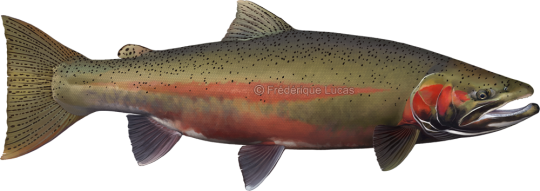

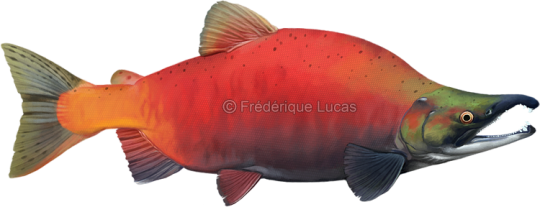
Strange salmon So after the Pink salmon I promised some bonus fish, and here they are! These three were also featured on the poster. They’re all a bit unusual; they’re either a salmon but don’t behave like one, or vice versa. In order they are:
Steelhead (Oncorhynchus mykiss irideus) Also known as: Rainbow, redband (trout)
Steelhead are the anadromous form of the Rainbow trout. Meaning they, just like salmon, live at sea but are born and return to spawn in freshwater. However, unlike salmon, they don’t die afterwards. After regaining their strength at sea they may return multiple times, and Steelhead as old as 11 years have been found spawning. Unlike regular rainbows these fish develop very salmon-like heads when spawning, with long faces and slight kypes. Their beautiful spotting is very fine and unusually regular on the tail. This unique patterning is always present and can be used to identify them even at sea. Thanks to the rich marine environment, Steelhead grow big: 48" (122 cm) and 55 lbs (25 kg) is maximum, but 20-30″ (50-75 cm) and 5-20 lbs (2.5-9 kg) average.
Coastal cutthroat trout (Oncorhynchus clarkii clarkii) Also known as: Sea-run cutthroat, Harvest (trout)
Coastal cutthroat are the anadromous form of the regular Cutthroat trout. Unlike Steelhead and Pacific salmon, Cutthroat do not make lengthy migrations out to sea. Often they just hang out in estuaries for a few months, spending much of the rest of the year in freshwater. Not all upriver migrations are to spawn either; sometimes they just want to overwinter or feed. When fresh out of saltwater Cutthroat can be quite silvery, with pale throat slashes. But as they approach spawning they become more and more yellow and the slashes that give them their name more pronounced red. Coastal cutthroats don’t grow very big: 24″ (60 cm) and 8 lbs (3.5 kg) is the recorded maximum, but average is 10-16″ (25-40 cm) and 1-5 lbs (0.5-2 kg).
Kokanee salmon (Oncorhynchus nerka) Also known as: Kennerly’s salmon/trout, Kokanee trout, Silver trout, Little redfish, Kikanning, Walla Kokanees are the landlocked form of the Sockeye. Instead of venturing to sea, they spend most of their time in lakes, swimming upriver from them to spawn. Their pocket size and habitat should make identification easy enough. Interestingly, they often bear spots on their back and tail, something Sockeyes never have. The red on their gill covers can also be more extensive. The comparatively nutrient poor lake environment keeps Kokanees at an almost dwarf size compared to Sockeyes. Maximum size is 20″ (50 cm) and 6.25 lbs (3 kg), but don’t expect more than 9-12″ (23-30 cm) and 1-3 lbs (0.5-1 kg) on average.
#illustrations#scientific illustration#Steelhead#steelhead trout#rainbow trout#rainbow#Oncorhynchus mykiss irideus#Oncorhynchus mykiss#Oncorhynchus#trout#Coastal cutthroat trout#Coastal cutthroat#cutthroat#Sea-run cutthroat#Oncorhynchus clarkii clarkii#Kokanee#Kokanee salmon#Kennerly's trout#Little redfish#Walla#Oncorhynchus nerka#Pacific salmon#fish#salmon#wildlife#digital art
75 notes
·
View notes
Text
Why Forests Need Salmon
(Originally posted at my blog at https://rebeccalexa.com/why-forests-need-salmon/)
One of my favorite fall activities is to check local streams for salmon runs. Here in the Pacific Northwest, and extending north into Alaska, we have seven species of anadromous Salmonidae: chinook salmon (Oncorhynchus tshawytscha), chum salmon (Oncorhynchus keta), coho salmon (Oncorhynchus kisutch), sockeye salmon (Oncorhynchus nerka), pink salmon (Oncorhynchus gorbuscha), coastal cutthroat trout (Oncorhynchus clarkii clarkii), and steelhead (Oncorhynchus mykiss). My favorite run is the chum salmon that run up Ellsworth Creek in southwest Washington each fall, but I’m honestly just happy to see any migrating salmon. And as I hike through stands of ancient western red cedar (Thuja plicata), I like to think about the many ways in which these and other forests need salmon for their ongoing health.
Anadromous fish are those that are born in fresh water, spend much of their adult lives in salt water, and then return to fresh water to spawn. Some, like Atlantic salmon (Salmo salar) and some populations of American shad (Alosa sapidissima) are iteroparous, meaning they can make this journey multiple times in a lifetime. Pacific salmonids, on the other hand, are semelparous, meaning that they spawn once and then die shortly thereafter. (From here on out I am going to use “salmon” as a general, casual term referring to both the Oncorhynchus species, and the steelhead and cutthroat trout.)
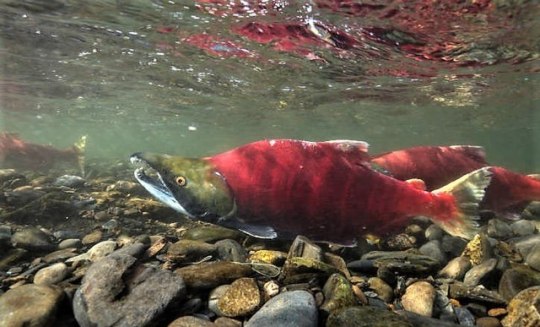
Pacific salmon were originally freshwater fish that inhabited lakes and slow-moving rivers. Somewhere around 25 million years ago, the climate cooled significantly, with average temperatures dropping almost twenty degrees F. We’re not sure at what point after this the salmon began expanding into brackish estuaries and then the Pacific Ocean itself, but when they did they found rich sources of food unlike what they had access to in fresh water. Over time, they evolved a life cycle that let them be born in the relatively safe shelter of freshwater streams, and then go out to the ocean to feast on the banquet found there when they were large enough to have a better chance of survival.
Eventually salmon runs could be found in streams as far inland as eastern Idaho, eastern British Columbia, and the southern two-thirds of Alaska (with some Alaskan runs even crossing over into Canada!) And until the arrival of European colonizers, these streams consistently provided indigenous people all along the Pacific coastline an incredibly important source of food, cultural and economic trade, mythos, and more. Unfortunately, the newcomers overharvested the salmon, dammed and destroyed streams and other habitat, and of course spearheaded the causes of anthropogenic climate change.

Indigenous people fish for salmon at Celilo Falls on the Columbia River. As the single longest continuously inhabited community in North America (over 15,000 years!), this location was a home and hub of cultural activity for many indigenous tribes and communities across the region before it was flooded by the completion of the Dalles Dam in 1957.
All these factors have led to a precipitous decline in the size of both salmon runs, and the salmon themselves. This isn’t just detrimental to indigenous communities, though. It also threatens the health of forests all throughout the salmons’ range.
A forest isn’t just made of trees. It’s composed of entire plant communities, fungi (including mycorrhizal species), and the animals, bacteria, and other living beings that share space with them. When salmon travel up and down the waterways as fry, and then later to spawn as adults, they have a direct impact on that ecosystem.
Salmon fry are an important source of food for larger fish, amphibians, birds, and other beings that seek food in the water. In fact, part of why salmon lay so many eggs (over 5,000 in the case of chinook!) is because most of the fry that hatch will never make it to adulthood. But adult salmon aren’t safe from predation on their return trip to their birthplaces. In fact, they are caught and eaten by a wide variety of animals from bears to eagles, wolves to osprey, sea lions to bobcats.
Bears are of particular interest here. Brown bears (Ursus arctos) are well-known for gorging on summer and fall salmon runs to build up massive amounts of fat in preparation for winter hibernation. (Katmai National Park even celebrates their bears during Fat Bear Week every October!) You can watch video feeds of several bears hanging out in their favorite fishing spots by waterfalls and in the flow of the river.
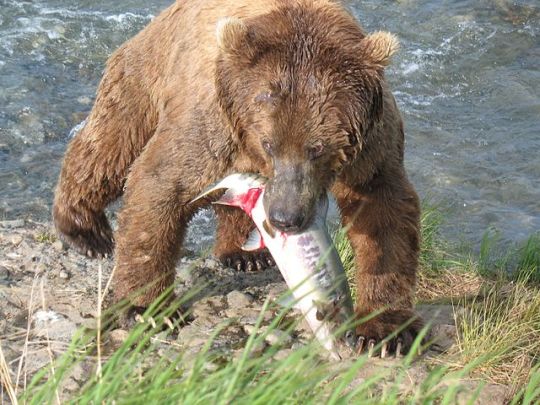
Imagine that you are a young bear, perhaps recently forced to independence by your mother who is now focused on your younger siblings. You have to not only start catching fish without her protection from bigger bears, but you also need to make sure those stronger bears don’t steal your catch. What’s the best thing to do? Run far away into the woods to eat your salmon in peace, then leave the remains among the trees and head back for more.
If the fishing is good, bears will often eat only the fattiest parts of the salmon like the brains and skin, and then leave the rest behind for scavengers. The nutrients in the salmon then disseminate throughout the forest, whether carried in the digestive systems of animals, or broken down in place by decomposers. This helps make the nutrients available to the plants, particularly trees which may store massive amounts of nutrients in their trunks; when the trees die, they essentially become a food pantry for younger beings like new seedlings, fungi, and so forth.
Now–what’s so special about the nutrients in salmon? Well, remember that these fish spend years out in the ocean. And the ocean has an entirely different balance of nutrients floating around in it compared to what’s found in fresh water or on land. The salmon are essentially the only way these ocean-borne nutrients can make their way into the forest in any meaningful amount, and they do so on a regular basis each year. The trees near salmon runs fished by bears may be 300% larger than usual, and salmon also provide nearly three quarters of the nitrogen in the forest. That’s a pretty impressive contribution!

This isn’t just about how forests need salmon; it’s a reciprocal relationship. While the salmon’s immediate habitats are aquatic, these streams, rivers, and other waterways are directly affected by what happens on the land around them.
Every waterway has a watershed–an area of land from which precipitation drains into that waterway. These watersheds nest within each other; the watersheds of small streams are nested within the watersheds of the rivers the streams feed into. That water carries things with it, from soil to pollutants. So the health of the land has a direct impact on what is found in the water.
But it goes beyond what’s washed downstream, and into how it’s washed down. In a healthy forest, for example, the soil is able to absorb a significant amount of precipitation that falls throughout the year, keeping it from simply cascading down hillsides to create flooding and landslides. Water is also stored in the various living beings in the forest; again trees are often the champions with their great size, but smaller plants help with water retention quite a bit as well, both through internal storage and preventing evaporation from soil. A forest that is badly damaged, such as through a clearcut or wildfire, won’t hold water as well. This can lead to floods, landslides and other erosion, and increase the impact of summer droughts as the land simply can’t store as much water, or for as long.
All of this affects the salmon directly. If the watershed is no longer holding and releasing snowmelt, rain, and other water in a controlled manner, this can lead to flooding in waterways which can wash away salmon eggs and fry. Increased erosion buries the gravel that salmon lay eggs in with silt, smothering the eggs so they never hatch. When a riparian zone–the land along a waterway–is stripped of vegetation, the water loses crucial shaded areas that keep temperatures cool. Salmon easily overheat when temperatures rise even a few degrees. And drought can dry up smaller streams, stranding and even killing young salmon while preventing adults from reaching their spawning grounds.
While not every single salmon run exclusively travels through forests, many of them do. And many spawning grounds are found in forests, or at least areas with significant tree cover in riparian zones. Salmon must have healthy forests in order to continue to survive, and the loss of these forests is just one of many factors contributing to their severe decline.
Thankfully, I am far from the only person concerned about the safety of our wild Pacific salmon. There are numerous organizations working to protect and restore salmon habitat through dam removal, preservation and restoration of aquatic habitat and surrounding land, regulations on salmon fishing, and educating people about sustainable seafood options (or just not eating seafood at all.) And even habitat restoration efforts that aren’t directly in salmon-inhabited waterways still have a positive impact on the forest ecosystem as a whole.
We know that forests need salmon, and salmon need forests. To protect one is to protect the other, and long may they both thrive.
Did you enjoy this post? Consider taking one of my online foraging and natural history classes, checking out my other articles, or picking up a paperback or ebook I’ve written! You can even buy me a coffee here!
#long post#salmon#fish#forests#nature#ecology#science#science communication#scicomm#wildlife#bears#Pacific Northwest#PNW#ecosystems#biology#extinction#endangered species#conservation#environment#environmentalism
609 notes
·
View notes
Note

You get a Cutthroat Trout
Oncorhynchus clarkii
you’ve sorta got the eyes of a girl whose survived a saw trap
WHAT 😭
493 notes
·
View notes
Text
Critter fact #13:
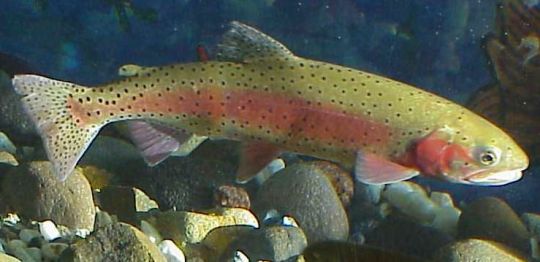
The Lahontan cutthroat trout (Oncorhynchus clarkii henshawi) is the state fish of Nevada. It is naturally found in the Lahontan basin and nearby areas, in northern Nevada and California.
38 notes
·
View notes
Text
Animal Crossing Fish - Explained MASTERPOST
So, here’s the Master list of ALL of the fish explained posts, with links, common and scientific names, and the “extra” topics we covered, if any. The AC Fish Explained Series went on from April 6th, 2020 to March 2021! The series continued into the Museum Tour in June 2021. The series was started again for “fish past” in November 2021. *Pocket Camp icons are from Nookipedia.com* *~*Now with over 200 entries. Thank you all for following along!*~*
If you liked the fish/science posts, please let me know! It makes me so happy to hear that people learned stuff from these! Without further adieu, here they are:
#1 Barreleye ~*~ (Macropinna microstoma) ~*~ Science in Video Games #2 Sea Bass ~*~ Japanese Sea Bass (Lateolabrax japonicus) ~*~ & Black Bass ~*~ Largemouth Bass (Micropterus salmoides) ~*~ Problems With Common Names #3 Sturgeon ~*~ Atlantic sturgeon (Acipenser oxyrinchus oxyrinchus) ~*~ Fish Migration #4 Football Fish ~*~ (Himantolophus spp.)~*~ Deep Sea Sex Life #5 Goldfish // Popeye Goldfish // Ranchu Goldfish ~*~ (Carassius auratus) ~*~ Goldfish Deserve Better
#6 Sea Butterfly ~*~ Common Clione (Clione limacina) ~*~ Problems with Common Names 2: Electric Boogaloo #7 Coelacanth ~*~ West Indian Ocean Coelacanth (Latimeria menadoensis) ~*~ Lazarus Species & Evolution of Tetrapods #8 Crawfish ~*~ Red Swamp Crayfish (Procambarus clarkii) ~*~ Invasive Species #9 Acanthostega ~*~ (Acanthostega gunnari) ~*~ Stem-Tetrapods #10 Killifish ~*~ Japanese Rice Fish (Oryzias latipes) ~*~ Endemism
#11 Oarfish ~*~ Giant Oarfish (Regalecus glesne) ~*~ Myths and Legends #12 Loach ~*~ Japanese Striped Loach (Cobitis biwae) ~*~ Barbels & Mouth Position in Fish #13 Clownfish ~*~ Ocellaris Clownfish (Amphiprion ocellaris) ~*~ Sequential Hermaphroditism #14 Surgeonfish ~*~ Regal Blue Tang (Paracanthurus hepatus) ~*~ The IUCN, Pet Trade #15 Koi ~*~ Amur Carp (Cyprinus rubrofuscus) subspecies ~*~ Aquaculture
#16 Manila Clam ~*~ Japanese littleneck clam (Ruditapes philippinarum) ~*~ Mollusks #17 Barred Knifejaw ~*~ Barred Knifejaw (Oplegnathus fasciatus) ~*~ Broadcast Spawning & Larvae Dispersal #18 Stringfish ~*~ Sakhalin Taimen (Parahucho perryi) ~*~ Anadromy & Osmolarity #19 Freshwater Goby ~*~ Dark Sleeper (Odontobutis obscura) ~*~ Motile Chromatophores #20 Ammonite ~*~ Ammonoidea spp. ~*~ Index Fossils
#21 Blue Marlin ~*~ Atlantic (Makaira nigricans) and/or Indo-Pacific (Makaira mazara) Blue Marlin ~*~ Apex Predators, Billfish Taxonomy #22 Giant Trevally ~*~ Giant Trevally (Caranx ignobilis) ~*~ Opportunistic Animals #23 Tuna ~*~ Bluefin Tuna (Thunnus spp) ~*~ Overfishing & Environmentally Sound Seafood #24 Mahi-Mahi ~*~ Mahi-Mahi (Coryphaena hippurus) ~*~ Meso-predators #25 Opthalmosaurus ~*~ (Ophthalmosaurus icenicus) ~*~ Convergent Evolution
#26 Tadpole & Frog ~*~ Japanese Tree Frog (Dryophytes japonicus) ~*~ Metamorphosis #27 Plesiosaur ~*~ (Futabasaurus suzukii) ~*~ Hydrodynamics of Long Necks #28 Archelon ~*~ (Archelon ischyros) ~*~ Eggs VS Live Birth #29 Snapping Turtle ~*~ Common Snapping Turtle (Chelydra serpentina) ~*~ Omnivores #30 Zebra Turkeyfish ~*~ Luna Lionfish (Pterois lunulata) ~*~ Venom, Invasive Lionfish
#31 Dace ~*~ Big-Scaled Redfin (Tribolodon hakonensis) ~*~ Acidic Water Tolerance #32 Carp ~*~ Common Carp (Cyprinus carpio) ~*~ 100 Most Invasive Species List #33 Bitterling ~*~ Rosy Bitterling (Rhodeus ocellatus) or Japanese Rosy Bitterling (Rhodeus smithii) or hybrid ~*~ Nomenclature #34 Crucian Carp ~*~ Crucian Carp (Carassius carassius) ~*~ Low Oxygen Adaptations #35 Cherry Salmon ~*~ Cherry/Masu Salmon (Oncorhynchus masou) ~*~ Semelparity VS Iteroparity #36 Anchovy ~*~ Japanese Anchovy (Engraulis japonicus) ~*~ Gills #37 Seahorse ~*~ Korean Sea Horse (Hippocampus haema) ~*~ Seahorses #38 Ribbon Eel ~*~ Ribbon Eel, (Rhinomuraena quaesita) ~*~ Sequential Hermaphroditism (Again) #39 Suckerfish ~*~ Common Remora (Remora remora) ~*~ Mutual Relationships #40 Neon Tetra ~*~ Neon Tetra (Paracheirodon innesi) ~*~ Neon Tetra in the Pet Trade
#41 Piranha ~*~ Red-bellied Piranha (Pygocentrus nattereri) ~*~ Bite Force #42 Arapaima ~*~ Arapaima/Pirarucu (Arapaima gigas) ~*~ Air-Breathing (Physostomes) #43 Pufferfish ~*~ Long-spine Porcupinefish (Diodon holocanthus) ~*~ Family Toxin #44 Ocean Sunfish ~*~ Ocean Sunfish (Mola mola) ~*~ Sunbathing fish #45 Spotted Garden Eel ~*~ Spotted Garden Eel (Heteroconger hassi) ~*~ Burrowing
#46 Horseshoe Crab ~*~ Atlantic Horseshoe Crab (Limulus polyphemus) ~*~ Horseshoe Crabs Are Amazing #47 Moon Jellyfish ~*~ Moon Jellfyfish (Aurelia aurita) ~*~ & Sea Anemone ~*~ Magnificent Sea Anemone (Heteractis magnifica) ~*~ Cnidarians #48 Butterflyfish ~*~ Oriental Butterflyfish (Chaetodon auripes) ~*~ Monogamy #49 Great White Shark ~*~ Great White Shark (Carcharodon carcharias) ~*~ Functional Endothermy & Shark Attack #50 Whale Shark ~*~ Whale Shark (Rhincodon typus) ~*~ Filter-feeding
#51 Hammerhead Shark ~*~ Scalloped Hammerhead (Sphyrna lewini) ~*~ Evolution of the Hammerhead/Cephalofoil #52 Saw Shark ~*~ Japanese Saw Shark (Pristiophorus japonicus) ~*~ Saw Shark VS Sawfish #53 Shark Tooth Whorl ~*~ Helicoprion spp. ~*~ Chimeras #54 Dorado ~*~ Dorado (Salminus brasiliensis) ~*~ Protecting Species for Profit #55 Guppy ~*~ Guppy (Poecilia reticulata) ~*~ Sexual Dimorphism
#56 Angelfish ~*~ Freshwater Angel (Pterophyllum scalare) ~*~ Parental Care #57 Vampire Squid ~*~ Vampire Squid (Vampyroteuthis infernalis) ~*~ Oxygen Minimum Zone #58 Giant Isopod ~*~ (Bathynomus giganteus) ~*~ Deep-Sea Gigantism #59 Tilapia ~*~ Nile Tilapia (Oreochromis niloticus) ~*~ Aquaculture Issues #60 Pascal ~*~ Asian Sea Otter (Enhydra lutris lutris) ~*~ Mom’s Fave Foods & Pascal the Philosopher
#61 Arowana ~*~ Asian Arowana (Scleropages formosus) ~*~ Species Definition #62 Sea Pineapple ~*~ Sea Pineapple (Halocynthia roretzi) ~*~ Chordate Zoology #63 Gigas Giant Clam ~*~ Tridacna gigas ~*~ Clam Myths #64 Horse Mackerel ~*~ Japanese Jack Mackerel (Trachurus japonicus) ~*~ Fisheries #65 Mantis Shrimp ~*~ Peacock Mantis Shrimp (Odontodactylus scyllarus) ~*~ Eyes
#66 Moray Eel ~*~ Kidako Moray Eel (Gymnothorax kidako) ~*~ Pharyngeal Jaws #67 Pale Chub ~*~Pale Chub (Zacco platypus) ~*~ Mate Choice #68 Hermit Crab ~*~ Passionfruit Hermit (Coenobita cavipes) ~*~ Vacancy Chain for Hermits #69 Squid ~*~ Bigfin Reef Squid (Sepioteuthis lessoniana) ~*~ Morphology #70 Ray ~*~ Red Stingray (Dasyatis akajei) ~*~ Batoids
#71 Napoleonfish ~*~ Humphead Wrasse (Cheilinus undulatus) ~*~ IUU Fishing #72 Scallop ~*~ Ezo Giant Scallop (Mizuhopecten yessoensis) ~*~ Swimming, Seeing Bivalves #73 Octopus ~*~ California Two-Spot Octopus (Octopus bimaculoides) ~*~ Intelligence #74 Soft-shell Turtle ~*~ Chinese Soft-shell Turtle (Pelodiscus sinensis) ~*~ Evolution of Turtle Shells #75 Pondskater ~*~ Aquarius paludum ~*~ Surface Tension
#76 Myllokunmingia ~*~ Myllokunmingia fengjiaoa ~*~ Cambrian Explosion #77 Gazami Crab ~*~ Gazami Crab (Portunus trituberculatus) ~*~ Swimming Crabs #78 Acorn Barnacle ~*~ Balanus trigonus ~*~ Crustacean Diversity #79 Bluegill ~*~ Bluegill (Lepomis macrochirus) ~*~ Fish Tails #80 Tiger Prawn ~*~ Giant Tiger Prawn ( Penaeus monodon) ~*~ Crustacean Lifecycle & Nauplius
#81 Sea Grapes ~*~ Sea Grapes (Caulerpa lentillifera) ~*~ Algae #82 Giant Snakehead ~*~ Northern Snakehead (Channa argus) ~*~ Invasive Snakeheads #83 Spinosaurus ~*~ Spinosaurus aegyptiacus ~*~ Swimming Dinosaurs #84 Umbrella Octopus ~*~ Flapjack Octopus (Opisthoteuthis californiana) ~*~ Oceanic Layers #85 Sea Slug ~*~ Hypselodoris festiva ~*~ Nudibranchs
#86 Salmon ~*~ Chum Salmon (Oncorhynchus keta) ~*~ The Changing Salmon #87 Char ~*~ White-Spotted Char (Salvelinus leucomaenis) ~*~ Problem with Dams #88 Golden Trout ~*~ California Golden Trout (Oncorhynchus mykiss aguabonita) ~*~ Rainbow Trout Subspecies #89 King Salmon ~*~ Chinook Salmon (Oncorhynchus tshawytscha) ~*~ Site Fidelity #90 Pearl Oyster ~*~ Akoya Pearl Oyster (Pinctada imbricata fucata) ~*~ Pearl Formation
#91 Chambered Nautilus ~*~ Chambered Nautilus (Nautilus pompilius) ~*~ Vertical Migration #92 Gar ~*~Spotted Gar (Lepisosteus oculatus) ~*~ Holostei Fish #93 Flatworm ~*~ Pseudoceros bimarginatus ~*~ About Flatworms #94 Diving Beetle ~*~ Cybister chinensis ~*~ How Insects Breathe #95 Giant Water Bug ~*~ Lethocerus deyrollei ~*~ Bite of the Toe Biter
#96 Sea Urchin ~*~ Purple Sea Urchin (Paracentrotus lividus) ~*~ Biological Symmetry #97 Yellow Perch ~*~ Yellow Perch (Perca flavescens) ~*~ Cannibalism #98 Oyster ~*~ Pacific Oyster (Crassostrea gigas) ~*~ Oyster Reefs #99 Catfish ~*~ Amur Catfish (Silurus asotus) ~*~ Catfish are Ridiculous #100 Dunkleosteus ~*~ Dunkleosteus terrelli ~*~ Placoderms
#101 Rainbowfish ~*~ Ornate Rainbowfish (Rhadinocentrus ornatus) ~*~ Endemism (Again) #102 Slate Pencil Urchin ~*~ Red Slate Pencil Urchin (Heterocentrotus mamillatus) ~*~ Urchin Spines #103 Saddled Bichir ~*~ Saddled Bichir (Polypterus endlicheri) ~*~ Synapomorphy #104 Nibble Fish ~*~ Doctor Fish (Garra rufa) ~*~ Ichthyotherapy #105 Sweetfish ~*~ Ayu (Plecoglossus altivelis) ~*~ Traditional Cormorant Fishing
#106 Sweet Shrimp ~*~ Amaebi (Pandalus eous) ~*~ Shrimp Taxonomy #107 Anomalocaris ~*~ Anomalocaris canadensis ~*~ Radiodontids #108 Venus’ Flower Basket ~*~ Venus’ Flower Basket (Euplectella aspergillum) ~*~ Sponges #109 Sea Cucumber ~*~ Japanese Spiky Sea Cucumber (Apostichopus japonicus) ~*~ Sea Cucumbers #110 Olive Flounder ~*~ Olive Flounder (Paralichthys olivaceus) ~*~ Flatfish Lesson 1 #111 Dab ~*~ Alaska Plaice (Pleuronectes quadrituberculatus) ~*~ Flatfish Lesson 2 #112 Mitten Crab ~*~ Chinese Mitten Crab (Eriocheir sinensis) ~*~ What Is a Crab? #113 Snow Crab ~*~ Snow Crab (Chionoecetes opilio) ~*~ Japanese Names #114 Dungeness Crab ~*~ Dungeness Crab (Metacarcinus magister) ~*~ Ocean Acidification #115 Red King Crab ~*~ Red King Crab (Paralithodes camtschaticus) ~*~ Imposter Crab
#116 Red Snapper ~*~ Northern Red Snapper (Lutjanus campechanus) ~*~ Longevity #117 Turban Shell ~*~ Horned Turban Snail (Turbo cornutus) ~*~ Snails #118 Trilobite ~*~ Cheirurus spp. ~*~ How Fossils Form #119 Whelk ~*~ Common Whelk (Buccinum undatum) ~*~ Predatory Snails #120 Sea Star ~*~ Brick Red Sea Star (Anthaster valvulatus) ~*~ All About Sea Stars
#121 Seaweed ~*~ Wakame (Undaria pinnatifida) ~*~ More Algae #122 Sea Pig ~*~ Sea Pig (Scotoplanes globosa) ~*~ Dueterostomes and Protostomes #123 Pike ~*~ Northern Pike (Esox lucius) ~*~ Aggression #124 Mussel ~*~ Bay Mussel (Mytilus trossulus) ~*~ Ecosystem Services #125 Abalone ~*~ Black Abalone (Haliotis cracherodii) ~*~ Biomimicry
#126 Pond Smelt ~*~ Wakasagi (Hypomesus nipponensis) ~*~ Ice Fishing #127 Spiny Lobster ~*~ Japanese Spiny Lobster (Panulirus japonicus) ~*~ Lobster Imposter #128 Lobster ~*~ American Lobster (Homarus americanus) ~*~ Immortality #129 Coconuts ~*~ Coconut Palm (Cocos nucifera) ~*~ Unorthodox Seed Dispersal #130 Betta ~*~ Betta/Siamese Fighting Fish (Betta splendens) ~*~ Labyrinth Fish #131 Blowfish ~*~ Fine Patterned Puffer (Takifugu poecilonotus) ~*~ Preparing Toxic Fugu #132 Gulliver/Gullivarrr ~*~ Black-tailed Gull (Larus crassirostris) ~*~ Seabirds #133 Eusthenopteron ~*~ Eusthenopteron foordi ~*~ You’re a Fish #134 Octopus Villager ~*~ Octopus spp. ~*~ Anatomy of an Octopus #135 Spider Crab ~*~ Japanese Spider Crab (Macrocheira kaempferi) ~*~ Big Animals in the Oceans
#136 Beach Shells ~*~ multiple spp. ~*~ General About Spp. #137 Penguin Villager ~*~ Sphenisciformes spp. ~*~ Penguins! #138 Firefly Squid ~*~ Firefly Squid (Watasenia scintillans) ~*~ Bioluminescence #139 Wardell ~*~ West Indian Manatee (Trichechus manatus) ~*~ Sirenia, the Manatees and Dugong #140 Lyle & Lottie ~*~ Japanese River Otter (Lutra nippon) ~*~ Extinct River Otters
#141 Spring Mackerel ~*~ Japanese Spanish Mackerel (Scomberomorus niphonius) ~*~ Scombrid Fish #142 Moorish Idol ~*~ Moorish Idol (Zanclus cornutus) ~*~ Fish in Culture #143 Barbel Steed ~*~ Barbel Steed (Hemibarbus labeo) ~*~ More F’n Cyprinids #144 Nomura’s Jellyfish ~*~ Nomura’s Jelly (Nemopilema nomurai) ~*~ Native Invader #145 Frog Villager ~*~ Anura spp. ~*~ Frogs vs Toads #146 Flying Fish ~*~ Bennet’s Flying Fish (Cheilopogon pinnatibarbatus) ~*~ How They Fly #147 Pineapple Fish ~*~ Japanese Pineapple Fish (Monocentris japonica) ~*~ Armor #148 Eel ~*~ Japanese Eel (Anguilla japonica) ~*~ Catadromous Lifestyle #149 Sea Bunny ~*~ Sea Bunny (Jorunna parva) ~*~ The Fuzz is a Lie #150 Hippo Villager ~*~ Common Hippo, (Hippopotamus amphibius) ~*~ Hippos
#151 Largehead Hairtail ~*~ Largehead Hairtail (Trichiurus lepturus) ~*~ Species Complex Confusion #152 Lumpfish ~*~ Balloon Lumpfish (Eumicrotremus pacificus) ~*~ Suction #153 Giant Catfish ~*~ Giant Lake Biwa Catfish (Silurus biwaensis) ~*~ Earthquake Fish #154 Kapp’n ~*~ Kappa ~*~ The Legend of the Kappa #155 Achilles Surgeonfish ~*~ Achilles Tang (Acanthurus achilles) ~*~ A Fish’s Achilles’ Heel #156 Comb Jelly & Northern Comb Jelly ~*~ Ctenophore spp. ~*~ Ctenophores Are Not Jellyfish #157 Flora ~*~ American Flamingo (Phoenicopterus ruber) ~*~ Flamingos! #158 Red Sea Bream ~*~ Madai (Pagrus major) ~*~ Seasonal Luxury #159 Goliath Frog ~*~ Goliath Frog (Conraua goliath) ~*~ Biggest Frog! #160 Bering Wolffish ~*~ Bering Wolffish (Anarhichas orientalis) ~*~ Wolffish #161 Bicolor Dottyback ~*~ Bicolor Dottyback (Pictichromis paccagnella) ~*~ Incertae sedis #162 Zebra Moray ~*~ Zebra Moray (Gymnomuraena zebra) ~*~ More Morays #163 Vampire Crab ~*~ (Geosesarma dennerle) ~*~ TFW the Pet Trade Discovers Things Faster Than Science #164 Phineas ~*~ Japanese Sea Lion (Zalophus japonicus) ~*~ Seals vs Sea Lions #165 Amberjack ~*~ Japanese Amberjack (Seriola quinqueradiata) ~*~ Farmed Predators
#166 Sakura Shrimp ~*~ Sakura Shrimp (Sergia lucens) ~*~ Actually Prawns #167 Black Ghost Knifefish ~*~ Black Ghost Knifefish (Apteronotus albifrons) ~*~ It’s Electric! #168 Black Clownfish ~*~ Ocellaris Clownfish - AGAIN! (Amphiprion ocellaris) ~*~ Polymorphism #169 Pink Anemonefish ~*~ Pink Skunk Clownfish (Amphiprion perideraion) ~*~ Mutuals with an Anemone #170 Wakin Goldfish ~*~ Goldfish (Carassius auratus) ~*~ Mutants #171 Skipjack Tuna ~*~ Skipjack Tuna (Katsuwonus pelamis) ~*~ Pollution? In my seafood? More likely than you think! #172 Yellowfin Tuna ~*~ Yellowfin Tuna (Thunnus albacares) ~*~ Associations #173 Tiger Catfish ~*~ Tiger Shovelnose Catfish (Pseudoplatystoma spp.) ~*~ Diverse Cats #174 Great Barracuda ~*~ Great Barracuda (Sphyraena barracuda) ~*~ Unique Predatory Methods #175 Atlantic Mackerel ~*~ Atlantic Mackerel (Scomber scombrus) ~*~ Being a Living Trawl Net
#176 Wendell ~*~ Walrus (Odobenus rosmarus) ~*~ Walrus! #177 Pacific Saury ~*~ Pacific Saury (Cololabis saira) ~*~ Seasonal Migration #178 Spotted Knifejaw ~*~ Spotted Knifejaw (Oplegnathus punctatus) ~*~ Range Expansion #179 Discus ~*~ Discus (Symphysodon discus) ~*~ Parenting like a Mammal #180 Harlequin Shrimp ~*~ Harlequin Shrimp (Hymenocera picta) ~*~ Tiny knights killing monsters
#181 Dr.Shrunk ~*~ Axolotl (Ambystoma mexicanum) ~*~ Dude looks like a baby - Neotany #182 Freshwater Crab ~*~ Red-Clawed Crab (Perisesarma bidens) ~*~ Multiple Moves to Freshwater #183 Flame Angelfish ~*~ Flame Angelfish (Centropyge loricula) ~*~ Being colorful af #184 Threadfin Butterflyfish ~*~ Threadfin Butterflyfish (Chaetodon auriga)~*~ Eyespot #185 Splendid Garden Eel ~*~ Splendid Garden Eel (Gorgasia preclara) ~*~ Another Garden Eel
#186 Splendid Alfonsio ~*~ Splendid Alfonsio (Beryx splendens) ~*~ Big Eyes #187 Manta Ray ~*~ Oceanic Manta Ray (Mobula birostris) ~*~ 2 Mantas #188 Giant River Prawn ~*~ Giant River Prawn (Macrobrachium rosenbergii) ~*~ Mr. Sexy Legs #189 Green Spotted Puffer ~*~ Green Spotted Puffer (Dichotomyctere nigroviridis) ~*~ 4 Terrible Teeth #190 Pot-bellied Seahorse ~*~ Pot-bellied Seahorse (Hippocampus abdominalis) ~*~ Male “Pregnancy”
#191 Herabuna ~*~ Japanese White Crucian Carp (Carassius cuvieri) ~*~ Exclusive Fish #192 Smalltooth Sand Tiger Shark ~*~ Smalltooth Sand Tiger Shark (Odontaspis ferox) ~*~ Shape of Shark Teeth #193 Silver Pomfret ~*~ Silver Pomfret (Pampus argenteus) ~*~ Lessepsian Migration #194 Japanese Halfbeak ~*~ Japanese Halfbeak (Hyporhamphus sajori) ~*~ Long Chin is Long #195 Alligator Villagers ~*~ Crocodilian spp. ~*~ Crocodiles, Caimans, Alligators, and Gharials!
#196 Clam ~*~ Manila Clam (Ruditapes philippinarum) ~*~ Carbon Sequestration and Climate Change Actually #197 Amazon Leaffish ~*~ Amazon Leaffish (Monocirrhus polyacanthus) ~*~ Cryptic Behavior #198 Red Lionfish ~*~ Red Lionfish (Pterois volitans) ~*~ Venom vs Poison #199 White Ribbon Eel ~*~ White Ribbon Eel (Pseudechidna brummeri) ~*~ Animal Elongation #200 Opah ~*~ Opah (Lampris guttatus) ~*~ Whole-Body Endothermy
#201 Yellow Boxfish ~*~ Yellow Boxfish (Ostracion cubicum) ~*~ Shell-Fish #202 Horsehair Crab ~*~ Horsehair Crab (Erimacrus isenbeckii) ~*~ Setae: Hair for Crab #203 Black Ruby Barb ~*~ Purplehead Barb (Pethia nigrofasciata) ~*~ How Endemism Happens #204 Longsnout Seahorse ~*~ Slender Seahorse (Hippocampus reidi) ~*~ Suction Feeding #205 Threadfin Trevally ~*~ African Pompano (Alectis ciliaris) ~*~ Larval Mimicry
#206 Gourami ~*~ Honey Gourami (Trichogaster chuna) ~*~ Color Edits #207 Duck Villagers ~*~ Anseriformes spp. ~*~ Duck Diversity #208 Weedy Stingfish ~*~ Weedy Stingfish (Scorpaenopsis cirrosa) ~*~ Scorpion Fish #209 Silver Arowana ~*~ Silver Arowana (Osteoglossum bicirrhosum) ~*~ Surface Predator #210 Longtooth Grouper ~*~ Longtooth Grouper (Epinephelus bruneus) ~*~ Growing Old - for Fish! #211 Yellow King Piranha ~*~ Yellow King Piranha (Serrasalmus ternetzi)~*~ Color Morph With it’s Own Binomial aka Confusing AF #212 Giant Squid ~*~ Giant Squid (Architeuthis dux) ~*~ The Search for a Deep Sea Giant #213 Rainbow Trout ~*~ Rainbow Trout (Oncorhynchus mykiss) ~*~ Subspeciation - Hows and Whys #214 Brook Trout ~*~ Brook Trout (Salvelinus fontinalis) ~*~ Trout? Almost as Bad as Bass! #215 Frogfish ~*~ Painted Frogfish (Antennarius pictus) ~*~ Form Follows Function
#216 Crystal Red Shrimp ~*~ Bee Shrimp (Caridina cantonensis) ~*~ Bred for Perfection #217 Pelly, Phyllis, & Pete ~*~ Great White Pelican (Pelecanus onocrotalus) ~*~ Pelicans! #218 Pelican Eel ~*~ Pelican Eel (Eurypharynx pelecanoides) ~*~ Deep-sea Mouth #219 Dark Banded Rockfish ~*~ Dark Banded Rockfish (Sebastes inermis) ~*~ Why Buying Local is Best #220 Diamond Tetra ~*~ Diamond Tetra (Moenkhausia pittieri) ~*~ Endemic and Endangered
#221 Crab ~*~ Christmas Island Crab (Gecarcoidea natalis) ~*~ Mass Migration #222 Yellow Starfish ~*~ North Pacific Sea Star (Asterias amurensis) ~*~ Water Vascular System #223 Violet Sea Snail ~*~ Violet Sea Snail (Janthina janthina) ~*~ Macroplankton #224 Lemur-Tail Seahorse ~*~ Japanese Seahorse (Hippocampus mohnikei) ~*~ Square Tails #225 Coconut Crab ~*~ Coconut Crab (Birgus latro) ~*~ NOT Nightmare Fuel #226 White Tuxedo Guppy / White Butterfly Koi / White Angelfish ~*~ Albinism, Luecism, and other color disorders #227 Blue Starfish ~*~ Blue Sea Star (Linckia laevigata) ~*~ The Rarity of Blue #228 Chip & CJ ~*~ American Beaver (Castor canadensis) ~*~ Debunking Beaver Myths
~~The Museum Tour - Habitats~~
#1 Open Ocean #2 Nearshore #3 Coral Reefs #4 Estuary #5 Rivers #6 Lakes and Ponds #7 Wetlands #8 Aquarium Hobby Tank #9 Polar Regions #10 The Abyss
~~Fish Dish Fridays~~
#1 Aji Fry #2 Salmon Bagel Sandwich #3 Squid Ink Spaghetti #4 Clam Chowder #5 Carpaccio di...
#6 Anchoas al Ajillo #7 Sea Bass Pie #8 Seafood Pizza #9 Poke
#animal crossing#fish#marine biology#ichthyology#shark#aquarium#science in video games#animal crossing fish explained#masterpost#masterpost1#habitats#environments#museum#long post
312 notes
·
View notes
Text
Heard the news about the dramatic new revision and understanding of cryptic subspecies of cutthroat trout, which complicates and changes how the US will approach preservation of the threatened greenback cutthroat? Essentially, the “greenback cutthroat” represents at least 2 distinct cryptic lineages of cutthroat trout, and Euro-American land management agencies had been rehabilitating the wrong fish.
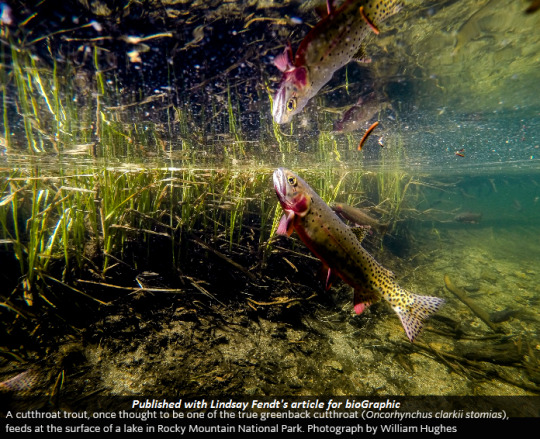
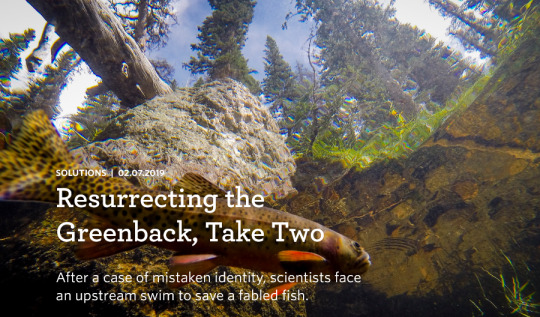
“A cutthroat trout, once thought to be one of the true greenback cutthroat (Oncorhynchus clarkii stomias) feeds at the surface of a lake in Rocky Mountain National Park.” From Lindsay Fendt, for bioGraphic: “Resurrecting the Greenback, Take Two: After a case of mistaken identity, scientists face an upstream swim to save a fabled fish” (February 2019).
-
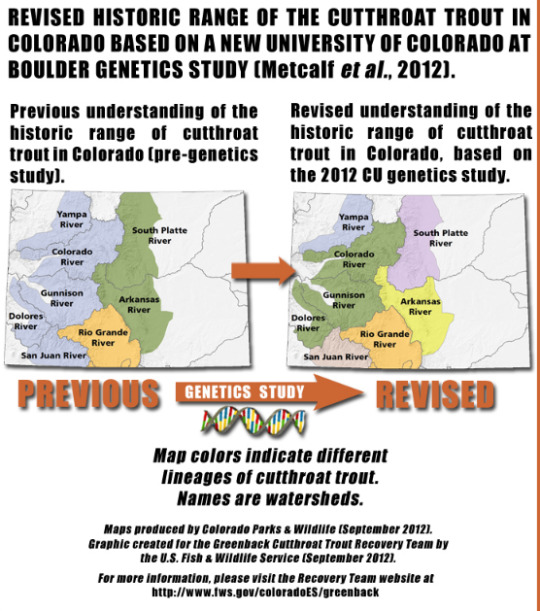
Despite all the attention that local land management agencies, outdoor recreation resort towns, and ultra-rich fly-fishing guide shops give to the “economic importance” (gross) of native cutthroat trout specifically, I still haven’t seen that many local land management agencies update distribution maps of cutthroat subspecies to reflect this pretty exciting research originally published in 2012. This is especially exciting to local enthusiasts of ecology, because the greenback cutthroat (Oncorhynchus clarkii stomias) is one of the most famous of the cutthroat subspecies; the greenback subspecies is Colorado’s formal “state fish” and was apparently understood to be endemic to waterways east of the Continental Divide, along the Front Range near Denver and Colorado Springs, making it one of the only cutthroat subspecies that lives in close proximity to the Great Plains. But it turns out that the greenback cutthroat is more diverse than originally thought. Basically, aside from the 3 known subspecies of cutthroat in Colorado, it seems that there were several (3) other cryptic lineages of cutthroat trout hanging out in the Colorado Rockies, but this has been difficult to detect because of how Euro-American land managers diluted native trout populations throughout the 20th century by stocking Colorado rivers with what they thought were the same subspecies (but were actually different subspecies) of cutthroat from different Colorado watersheds.
-----
This is important because it complicates the way that US agencies and Euro-American land management institutions were trying to remove protections for the greenback cutthroat. I highly recommend checking out Fendt’s great article. Here’s an excerpt:
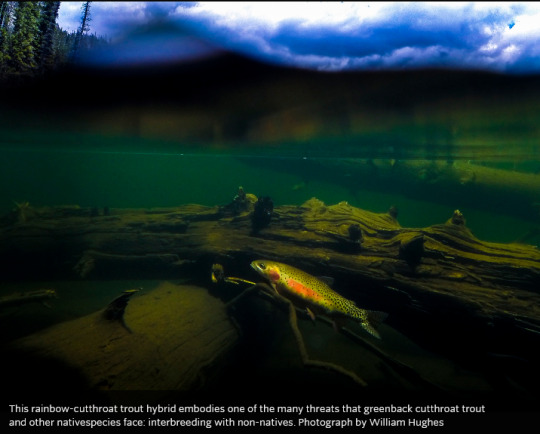
It’s early October in northern Colorado, and aspen leaves are falling in droves onto the surface of West Creek, a small stream that flows through Rocky Mountain National Park’s southeast corner. Rain from the night before has cast a perfectly formed rainbow across the sky and is feeding an invigorated flow of water over the stream’s rocks. The backcountry scene is undisturbed aside from three men slowly plodding along the stream, their equipment emitting a rhythmic beeping over the sounds of the gurgling creek. Wading in the water is Chris Kennedy, a fish biologist with the U.S. Fish and Wildlife Service. [...] As they make their way upstream, the men fill a bucket with a species of trout that Kennedy’s team had painstakingly stocked in the stream in previous years. At the time, the trout were thought to be greenback cutthroat trout (Oncorhynchus clarkii stomias), a critically threatened native subspecies that is also Colorado’s state fish. West Creek was one of more than a dozen sites where non-native fish were poisoned and removed to make way for greenback stocking, part of a 30-year, multi-million-dollar effort to restore the fish to its native range. The greenback was well on its way to being removed from the endangered species list when new genetic research changed the game. It turns out, the fish in Kennedy’s bucket aren’t greenbacks but a closely related cousin, a fish that was never actually native in these waters — and is abundant elsewhere.
[Photo also published with article.]

Basically, Euro-American land managers had been rehabilitating the wrong fish.
-----
There were, up until this past decade, 9 recognized living subspecies of cutthroat trout.
Here are the 9 traditional subspecies:
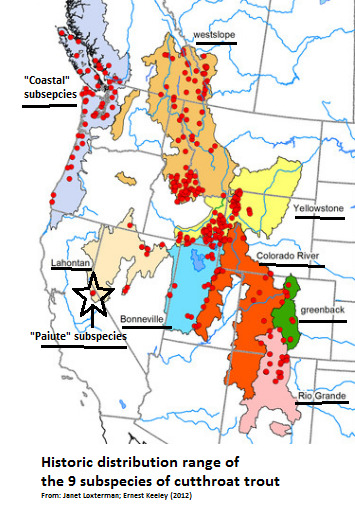
-----
From the original 2012 research, by Metcalf et al, here is the “traditional” understanding of cutthroat biogeography in the Colorado Rockies, where it was presumed that there were 3 living subspecies and 1 extinct subspecies (O.c. macdonaldi):
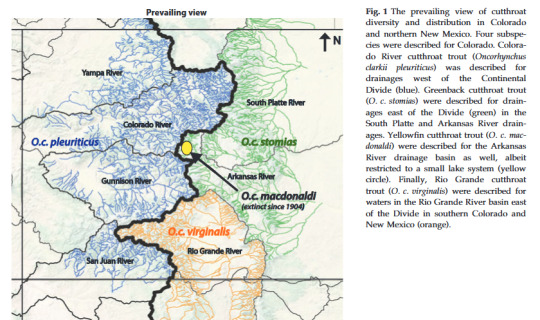
And here is the new understanding, where the subspecies known as the Colorado River cutthroat (O.c. pleuriticus) is actually 3 separate cryptic lineages, and the subspecies known as the Greenback cutthroat (O.c. stomias) is actually 2 separate lineages.
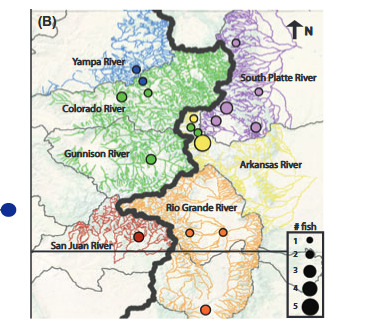
-----
Here’s how cutthroat subspecies from west of the Continental Divide were introduced to watersheds east of the Divide:
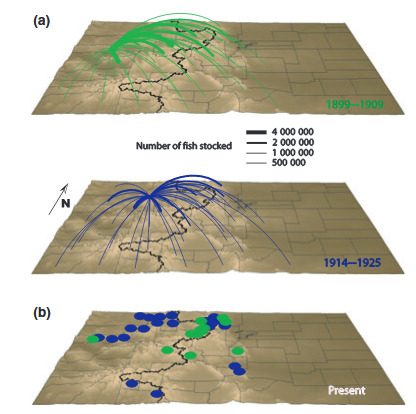
-----
These maps come from the original article; the research was published here:
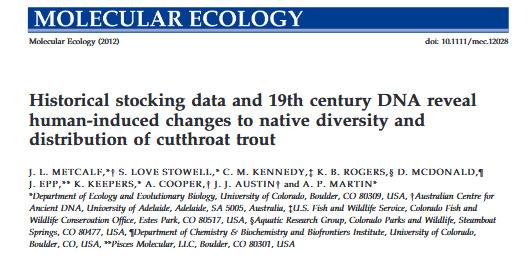
But there are also some shorter summaries available:

Excerpt: “With the insight afforded by the historical data, we now know with a great deal of certainty what cutthroat trout strains were here in Colorado before greenbacks declined in the early 20th century,” said Andrew Martin of CU’s ecology and evolutionary biology department. “And we finally know what a greenback cutthroat trout really is.”
---
Again, highly recommend Fendt’s article.

15 notes
·
View notes
Text
What Pacific Northwestern Salmonid is your muse?

Your Result: You are a Coastal Cutthroat trout! (Oncorhynchus clarkii clarkii)
What the heck? You're a trout? Bet you didn't expect that! Well here's the twist- the only thing separating most trout from salmon is their behavior- they're in the same genus. Most cutthroat trout prefer inland rivers and lakes, and will never set fin in the ocean, but you are different; you dare to dream...though you're still a little nervous about it! While you prefer to spend time on the coast instead of upstream, you're not really ready to go too far out into the ocean- and you prefer to spend the cold winters cozy in a stream. It's ok, though, you're already seeing horizons most cutthroat trout will never see- and you've got one up on your salmon friends: you won't die the moment you find love.
Tagged by: @candyredmuses Tagging: @thezomblr @hellrager @woofjock @zombfear @youngsouthey
3 notes
·
View notes
Text
What Pacific Northwestern Salmonoid is your muse?

You are a Coastal Cutthroat trout! (Oncorhynchus clarkii clarkii)
What the heck? You're a trout? Bet you didn't expect that! Well here's the twist- the only thing separating most trout from salmon is their behavior- they're in the same genus. Most cutthroat trout prefer inland rivers and lakes, and will never set fin in the ocean, but you are different; you dare to dream...though you're still a little nervous about it! While you prefer to spend time on the coast instead of upstream, you're not really ready to go too far out into the ocean- and you prefer to spend the cold winters cozy in a stream. It's ok, though, you're already seeing horizons most cutthroat trout will never see- and you've got one up on your salmon friends: you won't die the moment you find love.
Tagged By: @zombfear & @royalreef
Tagging: @ anyone who wants to do it.
#( Sweet Treats || Marcus Aesthetics.#I can't decide if it's funny and ironic that he got the same result as Brian despite them differing heavily.#he'd probably light up at that tbh#just#'i-i'm as cool as brian????!?!?!'
3 notes
·
View notes
Text
What Pacific Northwestern Salmonoid is your muse?

You are a Coastal Cutthroat trout! (Oncorhynchus clarkii clarkii)
What the heck? You're a trout? Bet you didn't expect that! Well here's the twist- the only thing separating most trout from salmon is their behavior- they're in the same genus. Most cutthroat trout prefer inland rivers and lakes, and will never set fin in the ocean, but you are different; you dare to dream...though you're still a little nervous about it! While you prefer to spend time on the coast instead of upstream, you're not really ready to go too far out into the ocean- and you prefer to spend the cold winters cozy in a stream. It's ok, though, you're already seeing horizons most cutthroat trout will never see- and you've got one up on your salmon friends: you won't die the moment you find love.
tagged by; @royalreef tagging; @purpleshopkeep @thezomblr @monstersmashed ( marcus )
3 notes
·
View notes